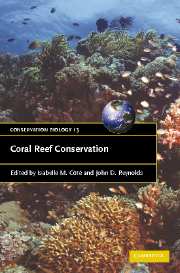Preface
Published online by Cambridge University Press: 05 June 2012
Summary
Coral reefs are found in the waters of more than 100 countries in tropical regions of the world, and provide food, income and cultural benefits to hundreds of millions of people. They cover a mere 0.1% of the ocean surface, yet they host a disproportionate amount of biodiversity, including nearly one-third of the world's marine fish species.
Coral reefs are under threat around the world. Recent estimates suggest that approximately 20% of the world's coral reefs have been destroyed and show no immediate prospect of recovery. Of those remaining, one-quarter are under imminent risk of collapse and another quarter face a long-term threat of collapse. For example, a recent comprehensive survey from the Caribbean found that since 1977, live coral cover across this region has decreased from 50% to 10%. This 80% decline in 25 years exceeds the rates of loss for any biome, including tropical forests. Equivalent measures of coral loss are not yet available for other regions, though 80–95% of coral cover was lost throughout large tracts of the Indian Ocean during the 1998 coral bleaching event, and there has been little recovery from many of these sites.
The main causes of coral reef degradation clearly originate from human activities, driven by growing human populations in coastal areas and lack of effective management of reef resources. They include over-fishing, which can damage reefs directly and also through the removal of herbivores that keep macroalgae in check, pollution and sedimentation due to coastal development and runoff from deforested lands, and warming of oceans due to climate change.
- Type
- Chapter
- Information
- Coral Reef Conservation , pp. xv - xxPublisher: Cambridge University PressPrint publication year: 2006
- 1
- Cited by



